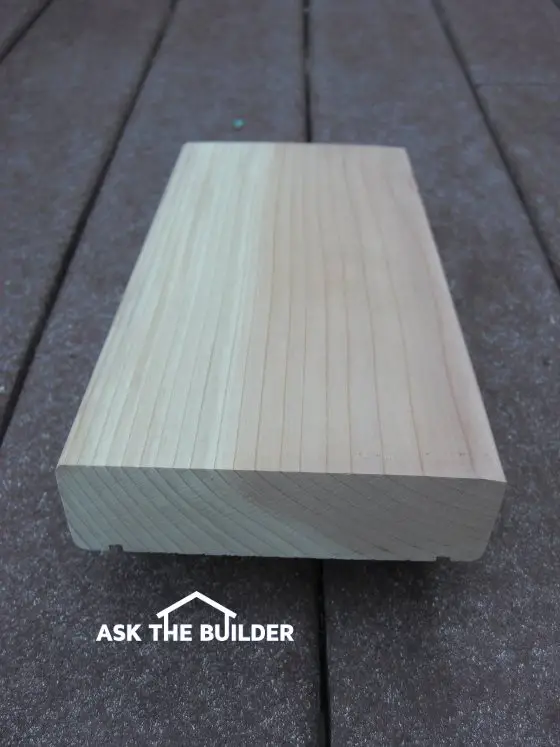Redwood Decking

This sample piece of redwood decking looks normal, but it’s not. It has a special profile that allows it to resist rot longer. Also this piece of wood decking has almost vertical grain. Note on the edge facing you the dark summer grain wood lines are nearly straight up and down. This wood grain profile is best for decking and ensures you don't have shards of wood peeling up from the deck that is common with flat-grained lumber. PHOTO CREDIT: Tim Carter
DEAR TIM: I'm about to build a new deck and really love the look and feel of real wood. All the composite decking materials try to mimic wood, so there must be a reason for that. I've got my eye on redwood decking and wonder if it's really all it's cracked up to be. Have you ever installed a redwood deck, and what can you tell me about the material? Are there any special considerations or new products that will allow the wood to last longer? What's involved in redwood deck maintenance? Bobbie M., Durango, CO
DEAR BOBBIE: I've worked with redwood for years as a builder and carpenter. I'd be lying if I didn't tell you I'm smitten with it. Not only is redwood gorgeous, it's naturally rot resistant. Granted, it's not as durable as oak or maple when it comes to hardness, but it makes up for this in so many other ways.
I agree with you about the plastics industry. For as long as I've been a builder, the vinyl siding business, the composite decking manufacturers, and even companies that make plastic interior trim moldings have tried to copy the look and feel of natural wood. That alone validates your personal attraction to wood.
It's my feeling that wood is hard coded into our DNA. Our ancestors used it to survive by making shelters, enlisted it to stay warm and dry, and made use of it as a cooking fuel. What I also love about wood, especially redwood, is that it's a crop not much different than wheat, corn or potatoes. The only difference is that the harvest time for redwood and other trees takes place after several years instead of months for most food crops. The bottom line is that we can grow redwood rapidly and continue to enjoy it for generations to come.
I used redwood on the last home I built for my family. It was used for all the siding and virtually all of the exterior trim. I didn't have a deck like you want, but I've installed quite a few redwood decks that still look as good as the day I drove the last stainless steel nail.
I love redwood because it's easy to work with and it has natural chemicals in it that make it rot resistant and not too tasty for most wood-destroying insects. It holds paint very well if you use it for a handrail. When you go to apply your redwood deck finish, you'll discover it readily accepts penetrating stains that will help preserve the natural grain and color of the redwood.
Understand that when you decide to use wood outdoors in just about any other location other than the Atacama Desert, where it often doesn't rain for decades, water is the enemy of wood. Redwood can be damaged by water, it just takes longer than other woods that you expose to water.
It's imperative that water not pond on horizontal deck boards and that water is allowed to drain away from between decking boards as rapidly as possible. The way redwood and many other lumber was milled for years produced boards that had parallel faces on each piece of lumber. While this seemed like a good idea at the time, it turns out that water could take advantage of this profile.
 You can now purchase redwood deck boards that have a very unique profile. The top surface of the boards has a slight crown to it like a roadway. This means the center of the board is slightly higher than the edges. Water readily flows off the top surface of the board.
You can now purchase redwood deck boards that have a very unique profile. The top surface of the boards has a slight crown to it like a roadway. This means the center of the board is slightly higher than the edges. Water readily flows off the top surface of the board.
The edges of the new redwood lumber are canted inwards slightly so that when two boards are placed next to one another, the gap at the bottom is wider than the top. This promotes excellent drainage and prevents organic debris from getting trapped between the separate pieces of lumber. Trapped organic debris holds water and accelerates wood rot.
Finally, the lumber mill cuts in two drip channels on the bottom of each board along the entire length. These grooves cause water that rolls under the wood to drip off the lumber instead of soaking in the underside. All of these things help extend the life of the redwood.
When choosing a redwood deck cleaner, I urge you to use oxalic acid or try a mild liquid dish soap and water. Avoid oxygen bleach as it can sometimes darken redwood. If your redwood darkens, you can often rejuvenate it by treating it with oxalic acid.
If you decide to use redwood for your deck, understand that this lumber comes in different grades. Some redwood is clear and free of knots. This is usually the most expensive.
You can get redwood that is less expensive that has tight knots in it. This grade is sometimes called Construction Grade. It will perform as well as clear, but it just lacks that perfect appearance.
Be sure to read all the written installation instructions published by the California Redwood Association before you construct your deck. Pay attention to the type of fasteners you're supposed to use. I would only use stainless steel nails or screws myself.
Column 854
One Response to Redwood Decking